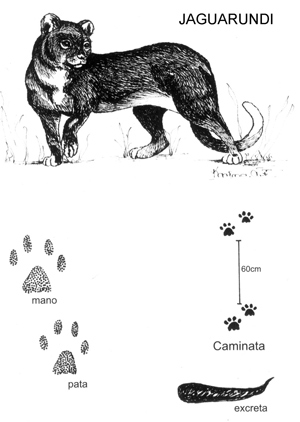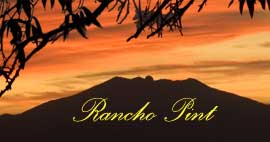|
Book Review
 By John Pint By John Pint
This very practical booklet on animal signs, tracks etc. in the
Primavera Forest--located just west of Guadalajara, Mexico--was
written and illustrated by Guardabosques (Forest Ranger) Karina
Aguilar and in the time-honored tradition of government
publications, bears a hefty title: “Guia de Identificación de
Rastros de Mamíferos en el Area de Protección de Flora y Fauna
Bosque La Primavera.” In spite of its ponderous title, however,
this booklet is actually slim and easy to use. It is only 66
pages long, so it will take up hardly any room at all in your
rucksack, but it provides a wealth of information about 18
fascinating mammals which live in the sprawling Primavera Forest
just west of Guadalajara. Included are: foxes, coyotes, pumas,
jaguarundis, bobcats, deer, peccaries, raccoons, badgers,
ringtails, skunks, ferrets, armadillos, possums, squirrels,
rabbits, gophers and voles.
Even though this guide is written entirely in Spanish, speakers
of any language will learn a great deal from Aguilar’s detailed
illustrations. These include a charming drawing of each animal
together with sketches of its front and back paw prints, a
diagram of its gait and even a drawing of its scat.
These illustrations will make it a snap for you to tell the
track of a ferret from that of an armadillo, because their paw
prints are radically different, but if you come upon the tracks
of a feline, how do you know whether they were made by a puma, a
bobcat or a jaguarundi, all of which roam el Bosque La
Primavera? Well, the drawings in this book show that, among
other things, the caminatas (gaits) of these animals are
quite different. Now, if you are lucky enough to spot a sample
of the animal’s scat, you may be able to say with confidence,
“what passed by here was a jaguarundi (Herpailurus
yagouaroundi) and nothing else!
 It is also possible that you will be entirely stymied because
all you see is one print and there is no convenient scat lying
next to it. Here is where a good knowledge of Spanish could save
the day. From her vast experience in the woods, Aguilar includes
a page or two of notes on each animal’s particular habits, its
favorite hangouts, oddities about its gait, the size of its paws
or what the leftovers of its meal typically look like. When all
of these factors are taken into consideration, even a
dyed-in-the-wool city slicker may correctly identify the signs
left along the trail by an animal you most likely will never
spot during the daytime. It is also possible that you will be entirely stymied because
all you see is one print and there is no convenient scat lying
next to it. Here is where a good knowledge of Spanish could save
the day. From her vast experience in the woods, Aguilar includes
a page or two of notes on each animal’s particular habits, its
favorite hangouts, oddities about its gait, the size of its paws
or what the leftovers of its meal typically look like. When all
of these factors are taken into consideration, even a
dyed-in-the-wool city slicker may correctly identify the signs
left along the trail by an animal you most likely will never
spot during the daytime.
Books like this guide allow us laymen to benefit from the
experience of specialists like Karina Aguilar, but all too
frequently such government or university publications somehow
forget to put the author’s name on the cover or the title page.
You might have no problem spotting the names of individuals who
supervised or approved the publication of the book, but you may
have to dig to find out who actually wrote it, which is the case
with this booklet.
I once attended a book launching in the town of Ahualulco. It
was for a scholarly volume published by the University of
Guadalajara (UDG) about the Piedras Bola. I sat in the audience
below a stage upon which several distinguished-looking
individuals were seated. One by one, they rose to give lengthy
speeches in flowery Spanish. While they droned away, I—like many
others in the audience, paged through my newly purchased copy of
the just published book. “I wonder what the elevation is where
these Great Stone Balls are lying,” I whispered to the person
sitting next to me. “1920 meters,” he answered without
hesitation. “How do you know that?” I asked.
“Oh, it’s because I wrote the section on the plants up there.”
“You’re one of the authors of the book?”
“Yes. I’m Miguel Cházaro.”
“Nice to meet you. But why aren’t you up there on the stage with
the other authors?”
“Oh, those aren’t authors. All of us authors are sitting down
here in the audience.”
“Well, then, who are those people up on the stage?”
“Ah, those are all VIPs.”
Well, to my amazement, at no time during the entire ceremony did
the VIPs on the stage ask the authors of the book to stand up
and take a bow. Somehow, they forgot to give credit to the
people who did all the work, but I don’t plan to make that
mistake in this review: Felicidades, Karina Aguilar! What a fine
job you have done!
This booklet is completely free of charge. You can pick it up at
the Forest Service headquarters in Guadalajara at CONCENTRO (Av.
Vallarta No. 6503 at the Periférico). They’re open from 9:00 to
4:00 weekdays, 9-2 on Saturdays, TEL 31-10-09-17. You can find
their office (Local E-38) easily by going into the main entrance
of the building (on Vallarta and surrounded by banks) and
turning left as soon as you pass a small water fountain. Keep
your eyes on the offices to your left. The Bosque’s is the only
one with flower pots and “little deer” on the floor outside the
door.
|

